Samsung Galaxy Tab S Review (10.5 & 8.4-inch)
by Anand Lal Shimpi on June 24, 2014 9:00 AM EST- Posted in
- Tablets
- Samsung
- Mobile
- Galaxy Tab S
Display
In addition to the dramatically reduced chassis thickness, the move to a Super AMOLED display is the other flagship feature of the Galaxy Tab S lineup. Both devices feature a 2560 x 1600 Super AMOLED panel. The 10.5-inch model features a derivative of the S-Stripe RGB subpixel layout and geometry we first saw in the Galaxy Note 2.
Each pixel features loosely spaced red, green and blue subpixels, with the latter being a thin strip in comparison to the more traditional rectangular red and green subpixels:
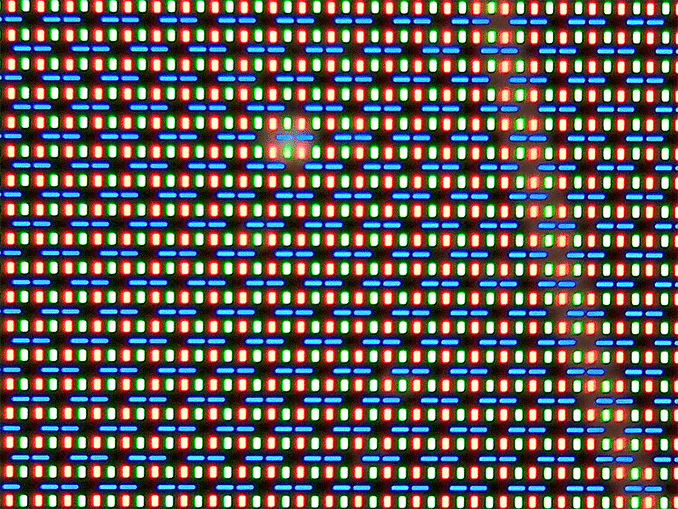
Samsung Galaxy Tab S 10.5, S Stripe RGB
Choosing different geometries for the blue subpixels makes sense as they have lower luminous efficiency than their red and green counterparts. Through balancing of subpixel size and drive power this design should allowed for equal luminance among all three subpixels. The uneven spacing is something new for the Galaxy Tab S 10.5, as the design looked far more structured back in the Note 2 days.
The 8.4-inch model by comparison uses a diamond PenTile RG,BG layout:
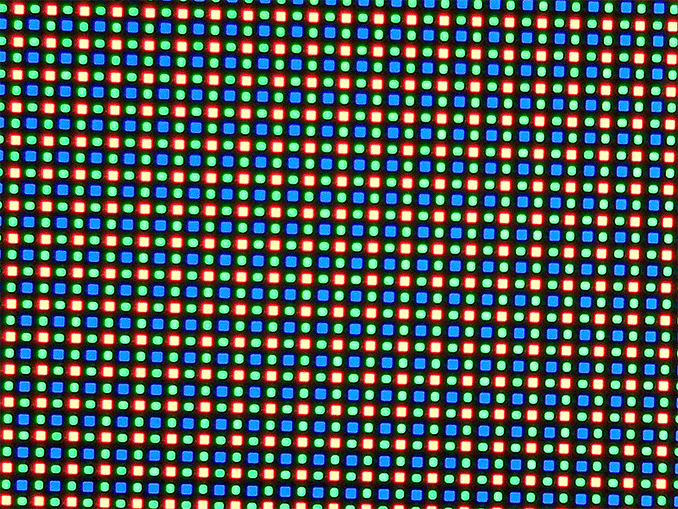
Samsung Galaxy Tab S 8.4, Diamond PenTile
This is similar to what we saw on the Galaxy Note 3, and just like before you get two subpixels per unit pixel instead of three in a traditional RGB stripe. Thankfully the pixel density on the Galaxy Tab S 8.4 is high enough that I wasn’t able to discern individual pixels or be bothered by the diamond PenTile layout. I will admit that I’ve never been the most sensitive to PenTile or PenTile-like sub pixel arrangements, so your mileage may vary.
With the Galaxy S5, Samsung finally delivered a reasonably accurate out of box display calibration as an option. In bringing AMOLED to its tablet lineup, I wondered if Samsung would do the same here. Thankfully the answer appears to be yes.
The new displays have the same adaptive setting as the GS5, which adjusts display tint based on ambient light temperature. There are three predefined color settings, down from the five on Galaxy S5, if you prefer something a bit more predictable.
Although Cinema ends up being the most accurate on the GS5, AMOLED Cinema doesn’t get the same treatment on the Galaxy Tab S. It’s actually the new basic mode that most closely tracks with sRGB. The two AMOLED modes trade off color accuracy for more saturation. I ran our display suite through all of the modes on the Galaxy Tab S 10.5 to illustrate the difference:
| Samsung Galaxy Tab S 10.5 Color Profiles | |||||||||
| Average White Point | Grayscale DeltaE 2000 | Gamut DeltaE 2000 | Saturation Sweep DeltaE 2000 | GMB ColorChecker DeltaE 2000 | |||||
| AMOLED - Cinema | 7540K | 5.2572 | 6.8855 | 5.9306 | 7.0418 | ||||
| AMOLED - Photo | 6576K | 1.7425 | 4.8109 | 4.5933 | 3.3633 | ||||
| Basic | 6516K | 1.8378 | 2.8114 | 2.6195 | 2.4249 | ||||
| Basic (Galaxy Tab S 8.4) | 6294K | 2.3914 | 3.4564 | 2.7639 | 2.2186 | ||||
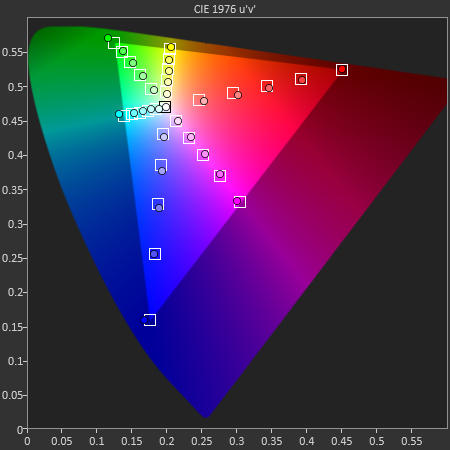
I’ve also included all of the CIE diagrams and test swatch comparisons in a gallery below if you want to have a closer look at what the AMOLED modes do. In short, both the photo and cinema modes oversaturate just in different ways. Photo appears to saturate evenly across all colors, while cinema mode compresses some while pushing out others.
As it’s the most accurate setting, I ran all of our comparison data with the basic mode enabled. In this mode the Galaxy Tab S’ display is among the best we’ve ever tested. On top of having good color accuracy, the new display delivers the awesome contrast ratio that AMOLED displays are known for. As you’ll see later on, there are definite power benefits as well when it comes to watching movies on these displays.
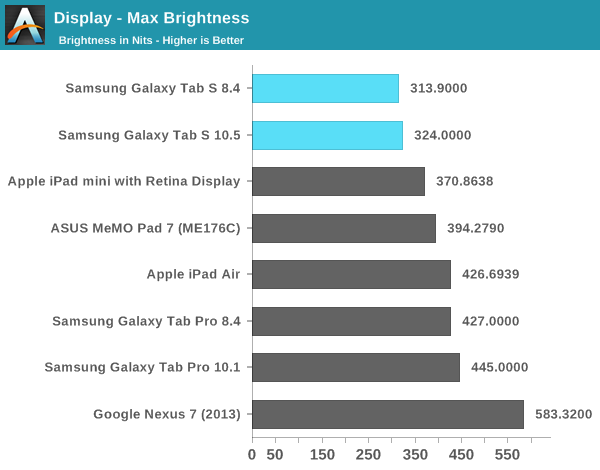
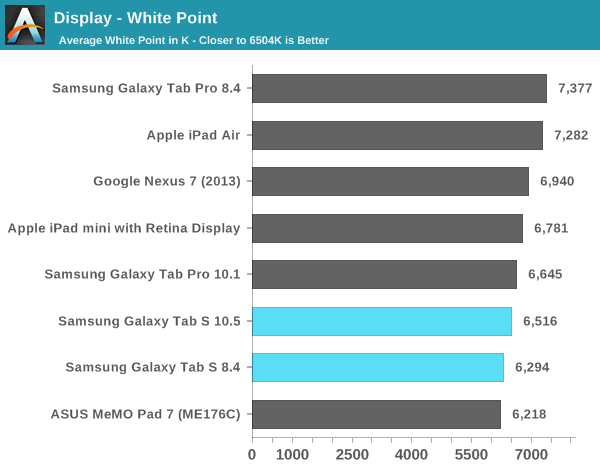
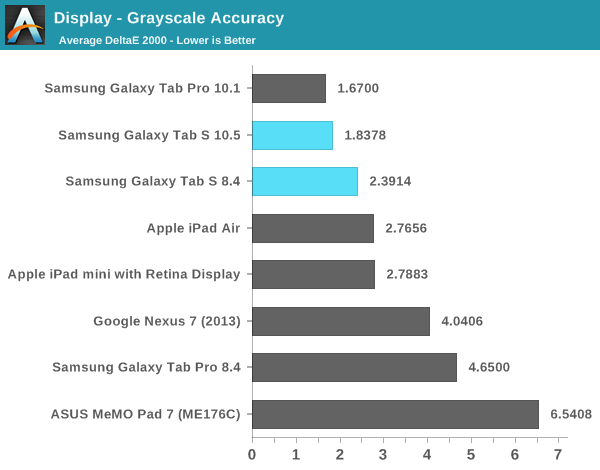
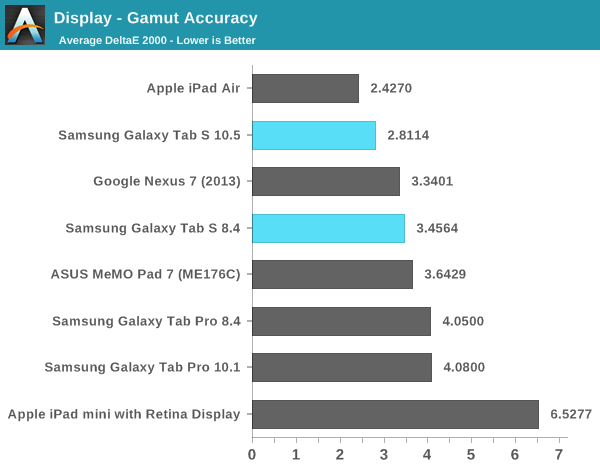

Samsung Galaxy Tab S 10.5 - Basic Profile

Samsung Galaxy Tab S 10.5 - Basic Profile

Samsung Galaxy Tab S 8.4 - Basic Profile

Samsung Galaxy Tab S 8.4 - Basic Profile
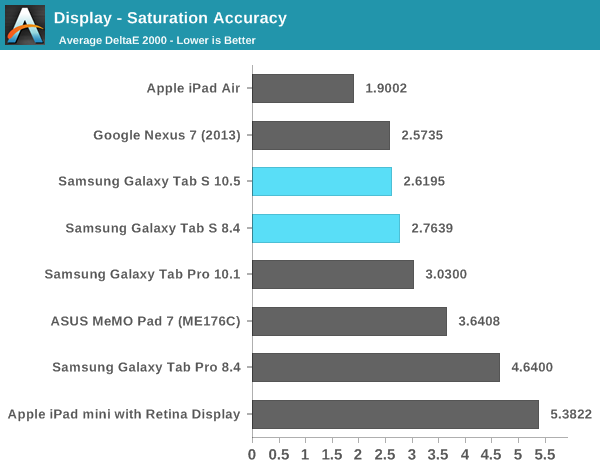

Samsung Galaxy Tab S 10.5 - Basic Profile

Samsung Galaxy Tab S 8.4 - Basic Profile
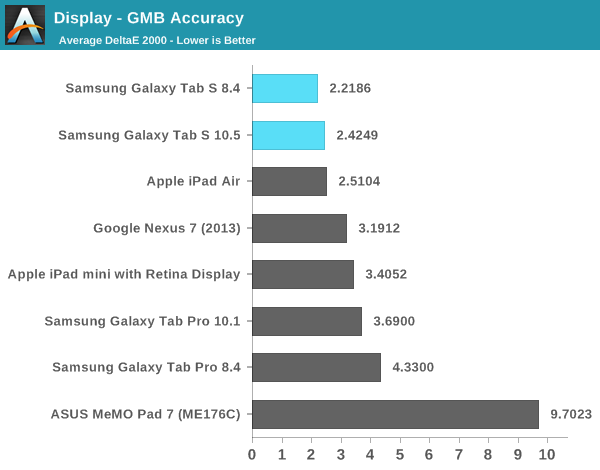
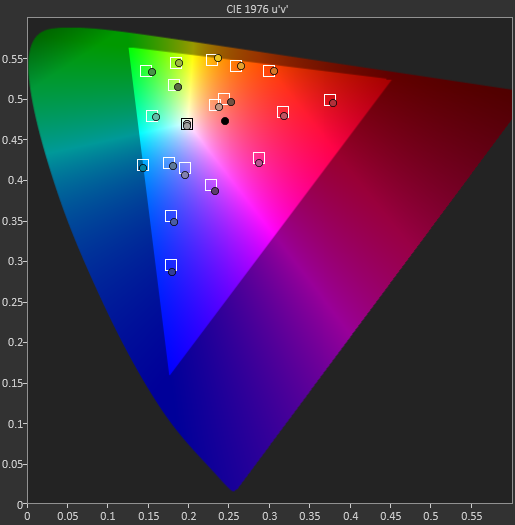
Samsung Galaxy Tab S 10.5 - Basic Profile

Samsung Galaxy Tab S 10.5 - Basic Profile

Samsung Galaxy Tab S 8.4 - Basic Profile

Samsung Galaxy Tab S 8.4 - Basic Profile


















98 Comments
View All Comments
akdj - Monday, June 30, 2014 - link
"Contrast is the single-most important part of subjective (ie: what peoples eyes say) display quality - according to every study ever done on it - and AMOLED displays have infinite contrast. Not sure why it wasn't tested here, but the ludicrous contrast makes this screen many-times superior to the iPad screen, IMO."A) contrast is NOT the single most important, subjective performance standard. Brightness and saturation. IE, 'Torch Mode!' That's why every TV at best buy is cranked to vivid, 100% pic and high saturation levels. NOT blacks and shadows. It's important to me, but as you've answered your own question, it's impossible to measure 'infinite contrast'. As OLED displays don't 'turn on' a pixel on black scenes, it's 'truly infinite' and hence impossible to measure. Though I'd argue if it's such a subjective and deciding quality, why aren't we using OLED displays to 'produce, color, and finalize' a motion picture? While DisplayMate's results do indeed separate these tablets, the overall scores are a point apart. Not leagues. I own the Note 3 and iPad Air as well as the retina mini and 5s. They're all phenomenal displays and excellent systems. To argue ones better than the other is like arguing pancakes vs waffles. They're both light years ahead of my Magnavox 13 channel (manual) 13" black and white I had in high school with rabbit ears ...or my first 16 'color' display after a decade in monochrome. LoL, kids these days ;)
mhannigan - Wednesday, June 25, 2014 - link
You obviously didn't understand correctly.spectrablue - Wednesday, June 25, 2014 - link
think again...http://www.displaymate.com/OLED_Tablet_ShootOut_1....
"Based on our extensive Lab tests and measurements, the Galaxy Tab S is the Best Performing Tablet Display that we have ever tested, not surprisingly with performance that is almost identical to the OLED Galaxy S5 Smartphone that we recently tested and found to be the Best Performing Smartphone Display"..."Comparisons with the Amazon Kindle Fire HDX and Apple iPad Tablet Displays: In 2013 the Amazon Kindle Fire HDX Tablets became the top performing Tablet displays in our Display Technology Shoot-Out series, leapfrogging the competition with cutting edge displays using Quantum Dots and Low Temperature Poly Silicon. But with the ever continuing and impressive improvements in display technology the Samsung Galaxy Tab S has now taken the lead for the Best Tablet Displays. The Apple iPad Air, which came in second after the Kindle Fire HDX 8.9, now moves into third place for Flagship Tablet models, and the iPad mini with Retina Display, with a very disappointing 63 percent of the standard sRGB/Rec.709 Color Gamut and poor Color Accuracy moves further down the pack for the Mini Tablet models. "
M4stakilla - Tuesday, June 24, 2014 - link
Does it contain the usual Samsung "crapware" or is this already a more "standard" Android device, like a Nexus?Linked to the above, does it receive Android updates immediately when they are released by Google or does it still take years before they get updated? (and how long will they be updated after release?)
GC2:CS - Tuesday, June 24, 2014 - link
How long ? About 18 months since release, eg until end of 2015.apandya27 - Tuesday, June 24, 2014 - link
Updates will definitely be delayed. 5-6 months is usual for *new* devices. That goes up to 8+ months for older devices.sherlockwing - Tuesday, June 24, 2014 - link
That video playback battery life!!!! If I am getting a new tablet(pretty happy with my Nexus 7 2013) the Tab S would certainly be my pick, Touchwiz be damned.nerd1 - Tuesday, June 24, 2014 - link
Touchwiz gives you easy access to many settings, as well as the multi-app multitasking capability, and better camera UI than most. I wonder why everyone hates touchwiz so much.GC2:CS - Tuesday, June 24, 2014 - link
Ok.... Anand did you noticed how much free memory these tabs got ?!?sherlockwing - Tuesday, June 24, 2014 - link
If it didn't take up 4Gb of internal storage for 1000 functions that I don't need & ancient UI elements(gingerbread era) eyesores I'd have a little less problem with Touchwiz. The better Camera UI thing is now irrelevant with the free Google Camera app, and I get to many key settings much faster on AOSP than I do on Touchwiz.